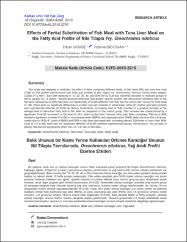Balık ununun bir kısmı yerine kullanılan orkinos karaciğer ununun Nil tilapia yavrularında, Oreochromis niloticus, yağ asidi profili üzerine etkileri
Abstract
This study was designed to evaluate the effect of diets containing different levels of fish meal (FM) and tuna liver meal (TLM) on the growth performance and fatty acid profiles of Nile tilapia fry, Oreochromis niloticus (initial mean weight: 2.29±0.07 g fish-1). Each diet replacing 0, 10, 20, 30, 40, and 50% FM by TLM was randomly allocated to triplicate groups of fish in aquaria for 13 weeks. Results demonstrated that final weight, specific growth rate and protein efficiency ratio of fish fed diets replaced up to 30% TLM were not significantly (P> 0.05) different from fish fed the control diet, except for TLM levels of ?40. There were no significant differences in protein and ash contents in whole-body, while dry matter and lipid contents were significantly affected (P< 0.05) by dietary treatments. Increasing level of TLM resulted in a gradual increase in the average level of saturated fatty acid in fish flesh as compared to the control group. This increase was characterized by a significant (P< 0.05) increment in the level of 16:0, which is the most common fatty acid. Diets containing TLM up to 30% showed a significant increase (P< 0.05) in monounsaturated (MUFA) and polyunsaturated (PUFA) fatty acid from the n-6 group, mainly due to 18:2n-6. Levels of MUFA and PUFA in fish flesh decreased with increasing dietary TLM levels of more than 40%. Level of n-3 in fish flesh was not significant different (P> 0.05) between experimental groups. Furthermore, the increase of dietary TLM did not significantly affect the n-3: n-6 ratio in fish flesh.


















